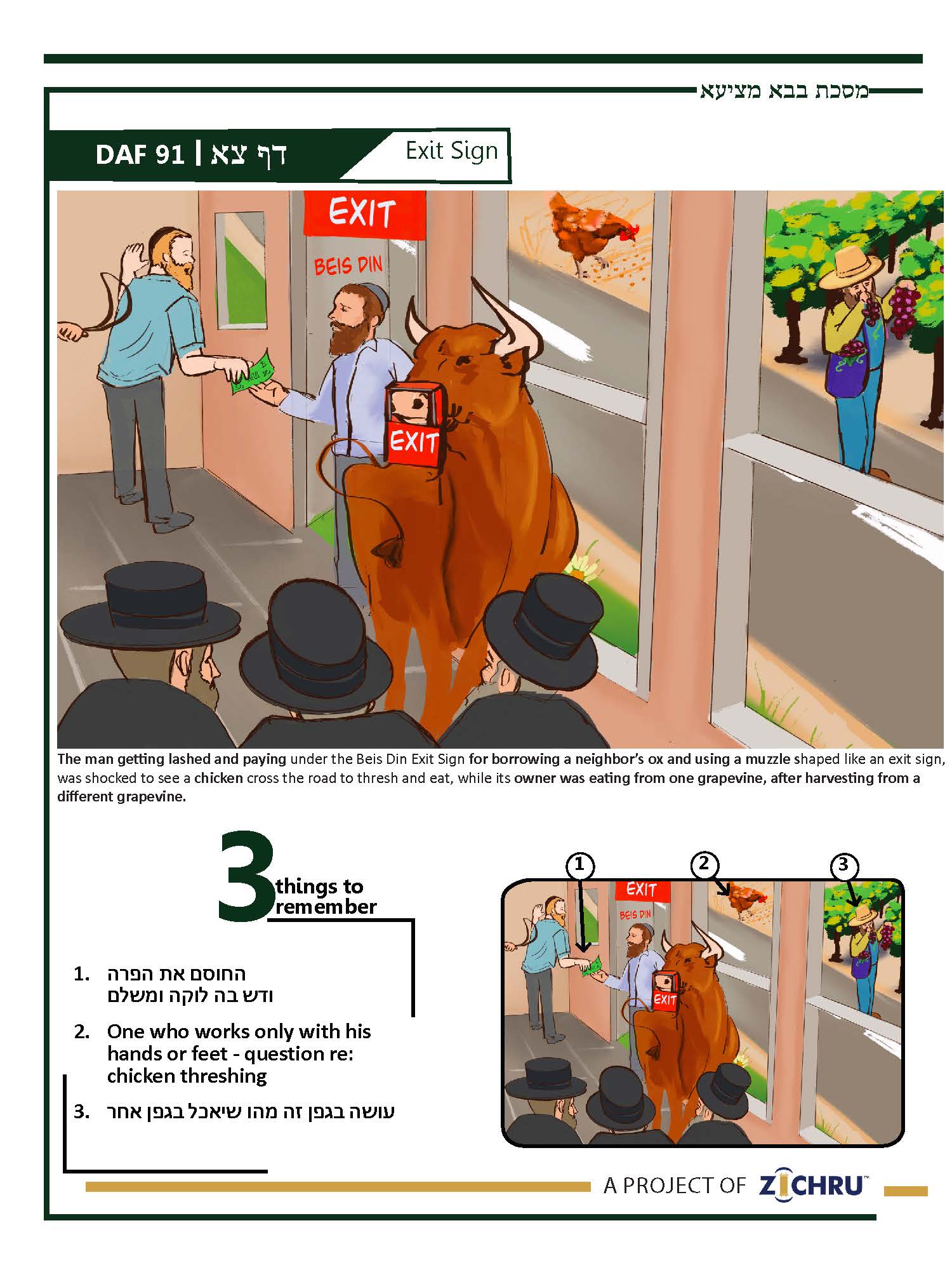Bava Metzia - Daf 91
- Audio Timestamps
0:00 - The 3 Sugyos
3:07 - Review of 3 Sugyos
6:00 - Siman
8:33 - 4 Blatt Back Chazarah
15:20 - Pop Quiz (Last 7 blatt)
For access to all Zichru resources including PDFs, and illustrations CLICK HERE
- החוסם את הפרה ודש בה לוקה ומשלם
In a Baraisa it was taught: החוסם את הפרה ודש בה לוקה – one who muzzles a (neighbor’s) cow and threshes with it receives lashes, ומשלם ארבעה קבין לפרה ושלשה קבין לחמור – and pays the owner four kavs for a cow, and three kavs for a donkey, which are the estimated amounts the animals would have eaten. The Gemara asks that the rule is אינו לוקה ומשלם – one does not receive lashes and also pay money for one violation!? Three answers are given: (1) Abaye says the Tanna is Rebbe Meir, who holds לוקה ומשלם – one does receive malkus and pay. (2) Rava says: אתנן אסרה תורה ואפילו בא על אמו – the Torah forbade a זונה’s pay for use as a korban, even if one had relations with his mother. Although such relations incur the death penalty, and Beis Din cannot force him to pay her wages, if he did pay, it cannot be used for a korban. This proves that essentially, he does owe the money, and must pay לצאת ידי שמים, and that is the intent of our Baraisa. Rashi adds that if the owner seizes the amount due him, he is not required to return it. (3) Rav Pappa answers that the obligation to feed the animal preceded the liability for malkus, because it began when he took the animal into his domain.
- One who works only with his hands or feet – What is halachah if a chicken threshes?
The next Mishnah states: היה עושה בידיו אבל לא ברגליו – Even if he was working with his hands but not his feet, or his feet but not his hands, אפילו בכתיפו – or even with just his shoulder, הרי זה אוכל – this worker may eat from the produce. Rebbe Yose bar Rebbe Yehudah says: עד שיעשה בידיו וברגליו – he cannot eat unless he works with both his hands and his feet. The Tanna Kamma holds the passuk implies that any work is sufficient to be entitled to eat, and Rebbe Yose holds his work must be similar to that of an ox, which works with its “hands and feet” (i.e., all four legs). Rabbah bar Rav Huna asked, what is the halachah if one threshes with geese or chickens (whose weight rests only on their feet), according to Rebbe Yose bar Rebbe Yehudah? Does he hold the critical similarity to an ox’s work is בכל כחו בעינן – we require that it work with all its ability, which would be satisfied by fowl threshing by foot, or does he literally require threshing with hands and feet, which is lacking in the case of fowl? This question is left unresolved.
עושה בגפן זה מהו שיאכל בגפן אחר
The next Mishnah states: היה עושה בתאנים לא יאכל בענבים – if he was working with figs, he may not eat grapes; if he was working with grapes, he may not eat figs. However, he may hold himself back from eating until he reaches superior fruit and eat his fill there. The Gemara asks: עושה בגפן זה מהו שיאכל בגפן אחר – if he was working with one grapevine, may he eat from another grapevine? Do we say: ממין שאתה נותן לכליו של בעל הבית בעינן – we require that he eat from the same species which you are putting into the owner’s vessel, and that requirement is fulfilled here, or do we say that he may only eat from the item he is putting into the owner’s vessel (i.e., working on), which is lacking in this case? If one may only take from the very item he is working with, then the Mishnah, which only prohibits taking grapes when working with figs (implying taking other figs is permitted), must be במודלית – where one is hanging over the other, and he is, in a sense, working with the grapes as well (since he must lift the branches of one to reach the other).
Siman – Exit Sign
The man getting lashed and paying under the Beis Din Exit Sign for borrowing a neighbor’s ox and using a muzzle shaped like an exit sign, was shocked to see a chicken cross the road to thresh and eat, while its owner was eating from one grapevine, after harvesting from a different grapevine.


